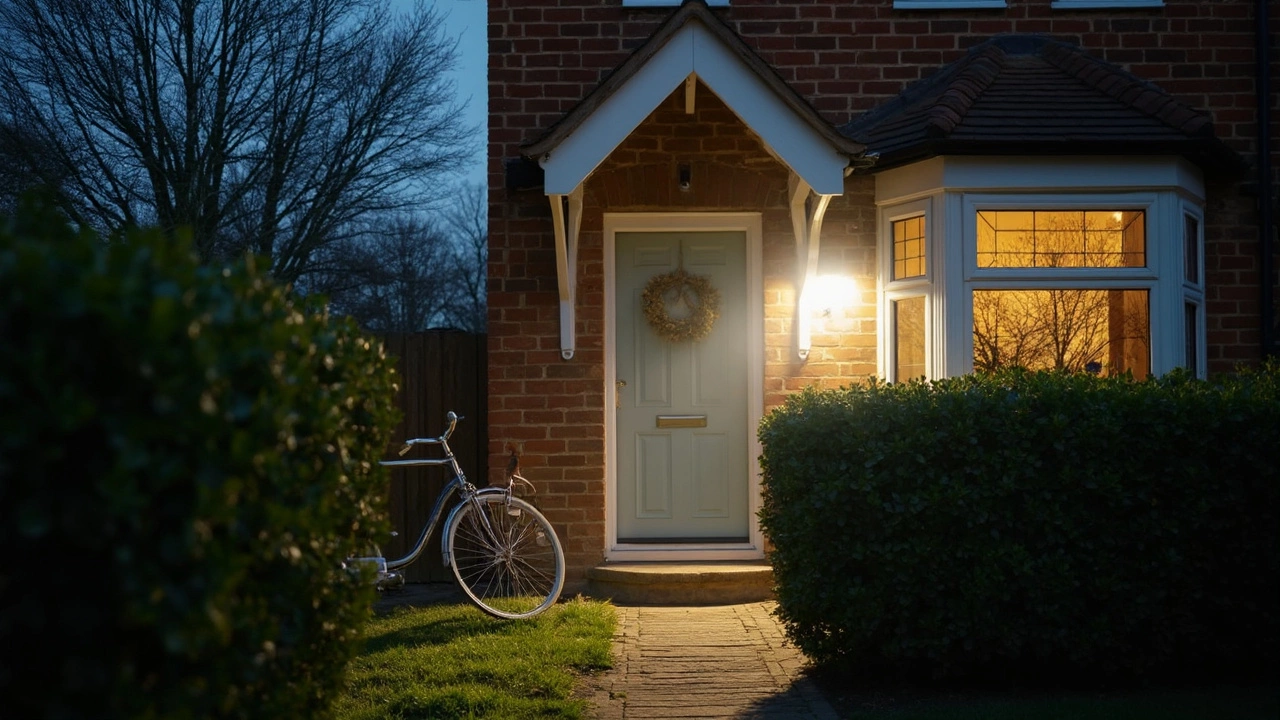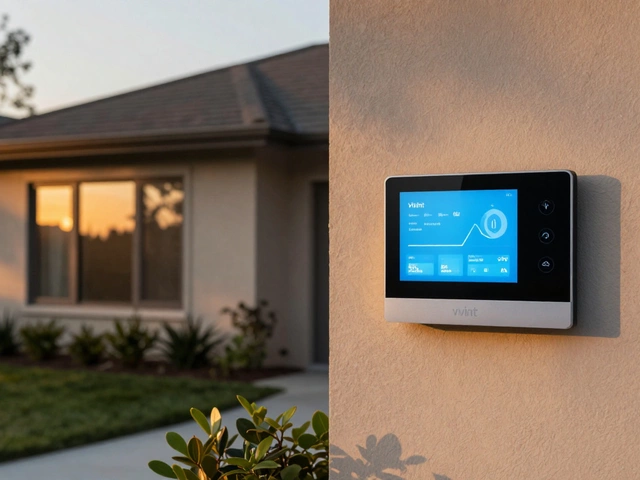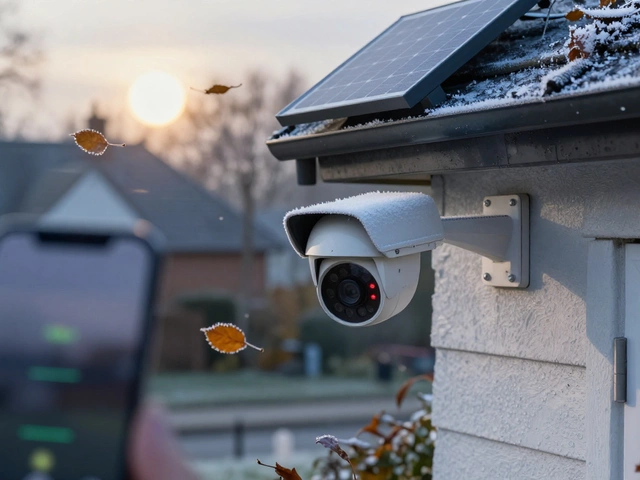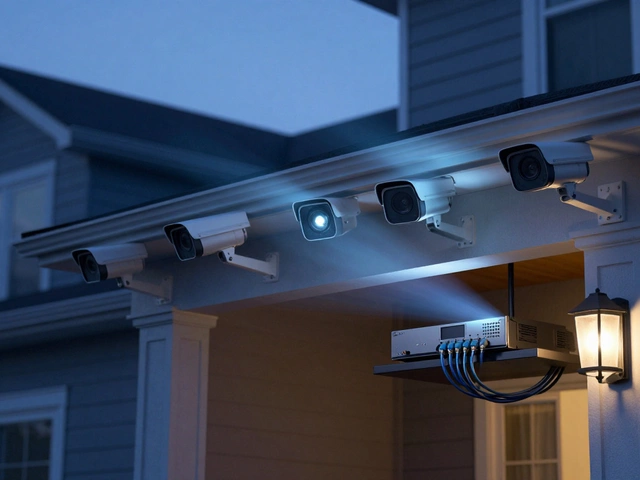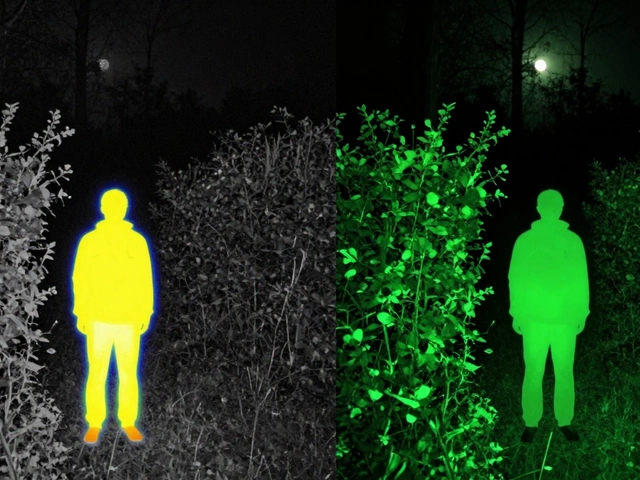If you’re shopping for an outdoor security light, that number on the box—lumens—matters way more than you’d think. Lumens are just the measure of how bright your light will be, and here’s the kicker: more isn’t always better. Flooding your yard with a mega-bright light can actually make it harder to see things if the glare is blinding or creates crazy shadows. Plus, your neighbors might not appreciate that midnight sun shining through their windows.
So, how bright should you go? For your front porch or a small doorway, something in the 700 to 1300 lumens range usually does the trick. If you’re lighting up a wide driveway or backyard fence line, you’re probably looking at anywhere between 1500 and 3000 lumens. Got a super dark alley next to your house? You might want to lean toward the higher end—but don’t just crank up the lumens and call it a day. The layout of your property, trees and shrubs, light color, and even humidity can mess with how effective your security light actually is.
And here’s a quick tip: motion sensor lights can be just as much of a deterrent as always-on ones, sometimes even more so. Thieves hate surprises. You don’t need to go nuclear with a 5000-lumen floodlight unless you’re running a car lot or a warehouse.
- What Are Lumens?
- Finding the Sweet Spot: Lumen Ranges for Outdoor Security
- Where Placement and Spacing Fit In
- Motion Sensors vs. Always-On Lights: Does It Change the Lumen Game?
- Surprising Factors That Can Affect Brightness
- Pro Tips for Getting the Most from Your Security Lighting
What Are Lumens?
If you’ve ever wondered why two security lights with the same wattage can look totally different in brightness, here’s the trick: it’s all about lumens, not watts. Wattage tells you how much power the bulb uses, but lumens measure the actual light you get out of it. That’s the practical number you want when dealing with outdoor security light choices.
In plain terms, the higher the lumens, the brighter the light. That’s why LED bulbs are so popular—they use a lot less power (watts) to pump out the same or even more lumens than old-school incandescent bulbs. For security, what matters isn’t just lighting up the area, but making details like faces and license plates clear enough to see. It doesn’t matter how much power you’re using if the light is weak.
Here’s a quick look at how common bulbs stack up for reference:
| Bulb Type | Watts (Typical) | Lumens Output |
|---|---|---|
| Incandescent (60W) | 60W | 800 lumens |
| Halogen (43W) | 43W | 800 lumens |
| Compact Fluorescent (CFL, 13W) | 13W | 800 lumens |
| LED (10W) | 10W | 800 lumens |
So, if you grab an LED rated at 1000 lumens, it’ll be way brighter and use less energy than a typical 60-watt bulb. Don’t get tricked by package claims or random watt numbers, always check the lumens to compare apples to apples.
If you’re lighting up a big area, you’ll want more lumens. If it’s just a doorway or a porch, you don’t need to go wild. But now you know what the numbers mean and why they actually matter for home safety.
Finding the Sweet Spot: Lumen Ranges for Outdoor Security
Here’s where things get practical. You don’t need a stadium light unless you’re actually hosting Friday night football games. For most homes, landing in the right lumen range means you light up what matters without wasting electricity or annoying the neighbors.
For entryways, porches, and small patios, security lighting with 700 to 1300 lumens is usually enough. This level is bright enough to see faces and find your keys, but not so intense that you’ll blind yourself every time you come home after dark.
If you’re dealing with a medium-sized driveway, single-car garage, or side yard, bump it up to somewhere between 1300 and 2500 lumens. This way, you’ll spotlight the whole space—enough to deter unwanted guests or see what’s making that weird noise out back.
Larger areas, like big yards, wide garages, or long driveways? Look for outdoor security lights offering 2500 to 4000 lumens. That’s bright enough to cover serious ground without turning your house into the neighborhood lighthouse.
- Front door or porch: 700–1300 lumens
- Side entrance or walkway: 1000–1800 lumens
- Driveway: 1500–3000 lumens
- Large yard or parking area: 2500–4000 lumens
And remember, bigger isn’t always better. Too much light can wash out details on security cameras and create deep shadows, making it easier for intruders to hide. Instead, match your outdoor security light to the size and purpose of the space. Think about where you actually need visibility versus where you just want a little glow. This way, you get enough security without overdoing it (and keep your energy bills in check, too).
Where Placement and Spacing Fit In
Even the brightest outdoor security light won’t help you much if it’s stuck in the wrong spot. Where you put the light and how you space them out can completely change how secure your yard actually is. A lot of people make the mistake of just plopping a single light above the door and calling it good. But that approach leaves blind spots—those ugly dark corners where motion or trouble can go unnoticed.
Here’s the deal: lights work best when they overlap a little, so there aren’t any big gaps in coverage. Instead of one giant floodlight, think about using a few mid-brightness lights spaced evenly along long driveways or fence lines. For walkways and backyards, aim to place lights high up (about 8–10 feet) which helps with spreading the beam wider and avoiding harsh glare in your eyes.
If you want some numbers, a good starting point is spacing lights about 15 to 20 feet apart. Smaller fixtures may need to be closer, while super-bright models can be spaced farther out—just watch against going so far that shadows sneak in. And don’t forget the angle; tilting the light slightly downward stops the beam from blasting into your neighbor’s window and shines it right where you want it.
Check this simple breakdown to see what’s typical for different spots:
| Location | Ideal Height | Recommended Spacing |
|---|---|---|
| Front Door/Porch | 6–8 ft | One per entrance |
| Driveway | 8–12 ft | 15–20 ft apart |
| Walkways | 8–10 ft | 10–15 ft apart |
| Backyard Fence | 10–12 ft | 20–30 ft apart (use 2000+ lumens) |
Don’t stress about rigid rules, though. Every yard is different, so give it a test at night with a flashlight or temporary lamp. Walk around, look for dark patches, and adjust your plan before drilling anything permanent into your siding.
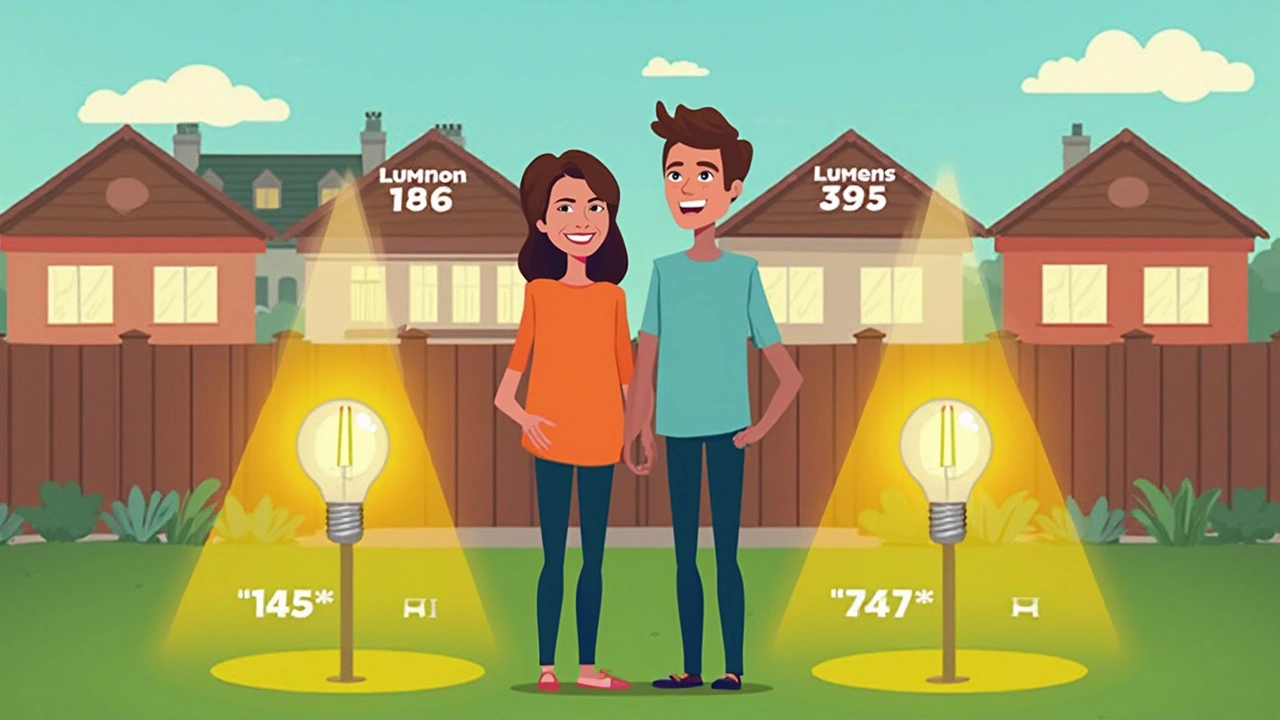
Motion Sensors vs. Always-On Lights: Does It Change the Lumen Game?
If you’re trying to pick between motion sensors and always-on lights, don’t just look at the price tag or a flashy box. How bright your outdoor security light needs to be actually depends a lot on how it’s used. With motion sensor lights, you don’t have to keep things super bright all night long. These are designed to pop on when something moves nearby, so a quick, strong blast of light—a sweet spot around 1200 to 2000 lumens—is usually enough to startle someone and show you what’s happening. The sudden brightness is often more effective as a scare tactic than a flood of constant light.
Always-on lights do best when you want steady, gentle coverage to light up paths, patios, or your driveway for hours at a time. Since they’ll be shining the whole night, you might actually want to use a little less power—think 700 to 1300 lumens for front doors or narrow walks, so you aren’t just wasting energy or making things uncomfortably bright. Nobody wants their porch glowing like a football stadium every night.
One surprising thing: security pros have found that houses lit up like an airport aren’t always safer. If you stick with motion sensors, you’re saving energy, money, and drawing instant attention only when it matters. Some newer motion sensor lights come with adjustable settings so you can tweak the sensitivity or how long the light stays on.
- Motion sensors: Bright flashes, great for jumpscares and saving energy.
- Always-on: Softer light, better for regular foot traffic and all-night coverage.
- Mix it up: Many setups use both for layered security.
Quick tip—test your motion lights’ range and angle when you install them. It’s pointless having 2000 lumens if the neighbor’s cat can set it off every ten minutes or it never lights up where you actually need it.
Surprising Factors That Can Affect Brightness
A lot of folks think buying a high-lumen outdoor security light is all you need, but there are several sneaky things that can make your light seem way dimmer or brighter than you planned. The real-world brightness you get doesn’t always match up with the number on the box.
For starters, the color temperature of your bulb matters. "Daylight" bulbs (around 5000K) will look sharper and harsher, while "warm white" bulbs (around 3000K) show up as softer, sometimes even looking less bright, even if the lumen output is the same. That’s why a 1000-lumen daylight bulb can feel more powerful than a 1300-lumen warm light.
Your surroundings play a huge part too. Dark walls or fences will soak up the light, while lighter surfaces bounce it back, making the area feel brighter. Got a bunch of trees or shrubs? Those will block and scatter your light, creating patchy coverage no matter how many lumens you throw at it.
Weather messes with you too. Heavy rain, fog, or even super high humidity can scatter and absorb light, shrinking your actual coverage zone. So, a light that’s perfect under clear skies might leave you in the dark during a storm.
Don’t forget about placement and angle—mounting your light too high or at a weird angle can throw shadows or miss key areas you were hoping to cover. Also, older fixtures with faded lenses or dirty covers can cut your brightness by 20% or more. Cleaning or swapping out old plastic covers can make a big difference.
If you notice your light looks weaker over time, the culprit could simply be old LEDs wearing out. LED chips lose brightness slowly, so swapping in a new fixture can give you a noticeable boost.
Here’s a quick rundown of what to double-check if your brand-new light doesn’t seem as bright as you expected:
- Check for dirt, leaves, or spider webs on the lens and clean it off
- Experiment with the angle—pointing the light more toward a wall or the ground often makes a huge difference
- See if anything blocks the light, like plants or overhangs, and trim or move as needed
- Make sure you picked the right color temperature for your space
Even the best security light won’t work well if it’s hidden behind a bush or aimed the wrong way. Tweak these factors, and you’ll get the most out of whatever lumens you’ve got.
Pro Tips for Getting the Most from Your Security Lighting
Here’s where a lot of people miss out—they install a good outdoor security light, but don’t get the maximum bang for their buck. A few simple moves can make a huge difference in how safe and covered your property is.
- Angle your lights smartly. Instead of shining the beam straight down, aim it across the area you want to cover. This cuts down on dark patches and makes everything more visible. For doorways and entry points, try a 22- to 30-degree angle for best results.
- Keep fixtures clean. Bugs, dust, and even spider webs seize every opportunity to dull your light’s brightness. Give them a quick wipe every few weeks—especially after pollen season or windy days. Clean glass lets more light shine through, which means you might even get away with a lower lumen count.
- Don’t forget about shadows. Trees and tall shrubs love to make hiding spots. Sometimes it's not about adding a brighter bulb, but putting lights on both sides of an object to kill the shadows. Two 800-lumen lights from different angles often work better than one massive floodlamp.
- Use timers and motion sensors for efficiency. These add-ons not only save energy but also make your place less predictable to anyone snooping around. A motion sensor light going off at 2 AM grabs way more attention than one that’s always on.
- Stick to daylight or cool white bulbs for detail. Lights around 5000K (that’s the color temperature, not lumens) make faces and license plates way easier to see on camera footage.
If you’re mounting a light near a busy street, you might want to install a shield or baffle. This keeps your lights focused on your property and out of drivers’ eyes—and keeps the neighbors happy, too.
Lastly, test your setup! Walk your property after dark and look for dead zones, blinding glare, or weak coverage. Tweak the angle and placement until everything feels safe and visible. Small adjustments are often what separate so-so security from the really effective kind.

